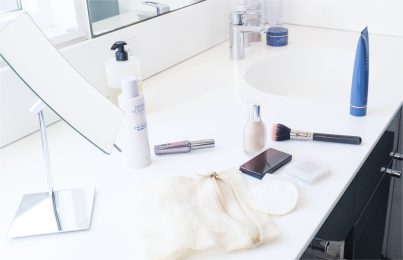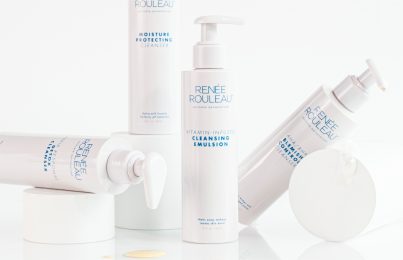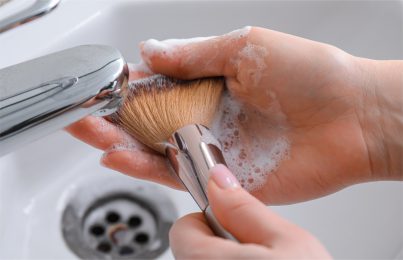Updated 04/29/24. It can be easy to dismiss your cleanser considering it gets rinsed down the drain approximately 60 seconds after being applied. I’ve seen it time and time again—people figure this is the least important part of their routine and are anxious to get to the fancy essences, serums, and face masks. Trust me when I say, this is a huge mistake in itself! Picking the right cleanser (and using it the right way) will make or break your skincare routine. It determines whether or not you have a clean slate so that the rest of your products can properly do their job.
- Mistake #1: You Use a Sonic Cleansing Brush or Another Aggressive Cleansing Method
- Mistake #2: You Use an Old-School Cleansing Balm to Remove Makeup
- Mistake #3: You Wash Your Face With Cleansing Wipes or Bar Soap
- Mistake #4: You Wait Too Long to Apply Your Next Product
- Mistake #5: You Skip Using Cleanser in the Morning
- Mistake #6: You Don’t Use a Washcloth to Help Remove Makeup
- Mistake #7: You Haven’t Invested in a Quality Cleanser
- Mistake #8: You Use the Wrong Cleanser for Your Skin Type
- Mistake #9: You Don’t Switch Out Your Cleanser Seasonally
In this post, I’ll share the nine most common mistakes people make when it comes to choosing, and using, a cleanser. Keep scrolling to see them all. Plus, learn easy solutions for each one!
Mistake #1: You Use a Sonic Cleansing Brush or Another Aggressive Cleansing Method
Have you ever applied an exfoliating acid serum or vitamin C serum and felt it sting the skin on your cheeks? This could mean your barrier is damaged due to an overly aggressive cleansing method. The culprit is usually a sonic cleansing brush (although a rough washcloth or harsh facial scrub could also be the cause).
When the bristles of a cleansing brush are rubbed over the face, they lift off dry skin. The one area that tends to get brushed too aggressively is the cheeks, and that’s for two reasons. The first is that they’re front and center on your face, so when you look in the mirror, they garner the most attention. The second reason is bone structure. The cheeks protrude, making the skin more taught, which naturally gives the brush the ability to work deeper in this area. This can also be true for the forehead and the chin. Using a cleansing brush too often, or too aggressively, will over-exfoliate the skin and lead to redness and irritation.
Pro tip: If you use a cleansing brush, be mindful. Make sure it’s getting evenly distributed over the face and use very light pressure. Don’t grind it into the skin (ouch!). The same goes for using washcloths and facial scrubs. Gentleness is key.
Mistake #2: You Use an Old-School Cleansing Balm to Remove Makeup
Have you ever used a cleansing balm and felt like your skin was silky soft after you rinsed it off? This happens because oil from the cleanser is still on your skin. You see, traditional balms are typically made of solid, waxy compounds and have a low melting point. This means they harden really easily and are super difficult to rinse off. This is why you always need to follow up with a second cleanser, but even then, you have to be very thorough. It can be tedious, and cleansing so much has the potential to irritate the skin.
The main problem here is that when you use traditional cleansing balms, it’s easy to end up with an oily residue left behind on your skin. This isn’t good news for anyone prone to clogged pores or breakouts. It also creates a barrier that makes it difficult for the rest of your products to penetrate properly.
For example, let’s say you want to apply a serum after using a cleansing oil or balm. Serums are generally made up of small molecules. You don’t want to put a small molecule on top of a large one (an oil). Doing so would prevent the smaller molecule from penetrating through, so your serum won’t perform as well as it should. I talk about how to avoid this in my post on double cleansing.
Pro tip: If you’re wearing heavier makeup, like long-wear foundation, and still want to use a balm-like cleanser, it’s just a matter of choosing the right kind. Oily cleansers are great for makeup removal because of the principle that like dissolves like (meaning, oil dissolves oil). The key is to look for a more modern cleanser that uses lightweight oils instead of solid waxes, such as Better Than Balm, an innovative, dual-phase cleanser that breaks down stubborn makeup and sunscreen and cleanses away dirt and environmental pollutants. One of my recent labors of love and a four time award-winner, this modern balm not only minimizes potential breakouts, but saves you time as well!
Mistake #3: You Wash Your Face With Cleansing Wipes or Bar Soap
Here’s the thing about cleansing wipes. Despite their name, they don’t actually cleanse the skin (well, not effectively). Instead, they lift off some makeup but smear the debris and makeup across the face. It’s the same thing as applying cleanser to your skin and not washing it off. In order to actually clean your skin, you need to use a cleanser with the addition of water to rinse away dirt, oil, and makeup.
I also never recommend washing your face with bar soap—no matter how expensive it is or how moisturizing it claims to be. The binders that hold a bar of soap together naturally have a high pH. This leaves the skin dehydrated and causes dry skin cell build-up. That’s why bar soaps are more suitable for the body, not the face. (Personally, though, I never use bar soap on my body either. I have a condition known as keratosis pilaris which causes little bumps to appear on my skin. Bar soaps only make this condition worse).
Pro tip: Switch out your bar soap for a sulfate-free cleansing gel and reserve cleansing wipes for rare occasions like camping, since no wipe will ever be as effective as a proper cleanser.
Mistake #4: You Wait Too Long to Apply Your Next Product
You have a one-minute window after washing your face before moisture evaporation starts to occur. Moisture evaporation leads to dehydration through a process called transepidermal water loss. (FYI, there’s a difference between dryness and dehydration). To avoid this, immediately apply an alcohol-free toner after cleansing. Leave it damp, then proceed with a serum or moisturizer. I call this the “Golden Minute Rule,” and it’s the easiest way to maintain good moisture levels in the skin.
Pro tip: After you finish washing your face, apply your next product quickly. Whether it’s an alcohol-free toner or a serum, have it nearby and ready to go. On that note, here’s the perfect step-by-step morning routine and step-by-step evening skin routine.
Mistake #5: You Skip Using Cleanser in the Morning
Your skin doesn’t have any makeup on it in the morning and you washed your face the night before, so it’s not necessary to use a cleanser, right? Not so fast. When you wash your face in the morning, you’re removing toxins and sebum (oil) that were excreted while you were sleeping. You’re also removing remnants of your nighttime products. This means that your daytime products (particularly sunscreen) have a clean slate to work with. Learn more about why washing your face in the morning is necessary.
Pro tip: You won’t strip your skin of moisture by washing your face twice a day, as long as you’re using a gentle, sulfate-free cleanser. If you’ve had trouble finding a cleanser that won’t leave your face feeling dry and tight, I suggest using the Moisture Protecting Cleanser. It has a nice low pH, barely foams, and leaves the skin soft and healthy-looking.
Mistake #6: You Don’t Use a Washcloth to Help Remove Makeup
Have you ever wiped your face with toner after cleansing only to find makeup on the toning cloth? This is all too common. What you need to know is that cleansing lotions and blams dissolve makeup as they’re massaged over the skin. When you rinse your face, some of that makeup is washed away, but it’s the actual wiping action from a washcloth that lifts it all off the skin.
Pro tip: Wash your face, rinse as usual, then follow up with a gentle wiping action using a soft cloth. You want to use something very soft and gentle to make sure you aren’t being too aggressive with your skin. Here are step-by-step instructions for washing your face.
Mistake #7: You Haven’t Invested in a Quality Cleanser
Are you putting your money into leave-on products, such as serums, and skimping on your cleanser because you think it’s just being rinsed off anyway? This is a thought many people have. It’s also where many people go wrong.
I can assure you that if the first product in your skincare routine isn’t working effectively, then the rest of your products won’t work effectively either. The biggest mistake people make is skimping on a cleanser. They opt for a low-quality one and don’t pay much attention to the ingredients. This leads to people using cleansers that are drying, which leads to unnecessary irritation.
Pro tip: Look for a cleanser that is free of common irritants like sulfates and synthetic dyes. All of the cleansers in my skincare line fit the bill.
Mistake #8: You Use the Wrong Cleanser for Your Skin Type
Don’t let anyone tell you that skin types aren’t real. If you’re in your 20s and dealing with adult acne, your skin has different requirements than if you’re in your 50s and dealing with dryness. One size does not fit all when it comes to the skin. I believe there are 9 Skin Types and you need the right cleanser for each one.
Pro tip: If you’re unsure of your skin type, take the Skin Type Quiz to find out. At the end of it, you’ll get the perfect cleanser recommended for your unique goals and concerns (along with other product recommendations like toners, serums, masks, and more). It takes all of the guesswork out of curating an effective skincare routine.
Mistake #9: You Don’t Switch Out Your Cleanser Seasonally
The climate in which you live directly affects your skin’s ability to retain moisture and balance oil production. If you live in a humid environment or have oily skin, I recommend using a gel cleanser. These can help remove excess oil and keep the skin in a balanced state. If you live in a dry environment, a lotion-based cleanser may be best.
Pro tip: Reassess your cleanser (and all of your other products) every time the season changes.
There you have it! These are the top cleansing mistakes I often see people make. Cleansing your skin is an incredibly important part of your daily skincare routine, so make sure you’re avoiding these common pitfalls!
Next, find out how to choose the best moisturizer for your skin type.
Celebrity Esthetician & Skincare Expert
As an esthetician trained in cosmetic chemistry, Renée Rouleau has spent 35 years researching skin, educating her audience, and building an award-winning line of products. Her hands-on experience as an esthetician and trusted skin care expert has created a real-world solution — products that are formulated for nine different types of skin so your face will get exactly what it needs to look and feel its best. Trusted by celebrities, editors, bloggers, and skincare obsessives around the globe, her vast real-world knowledge and constant research are why Marie Claire calls her “the most passionate skin practitioner we know.”



